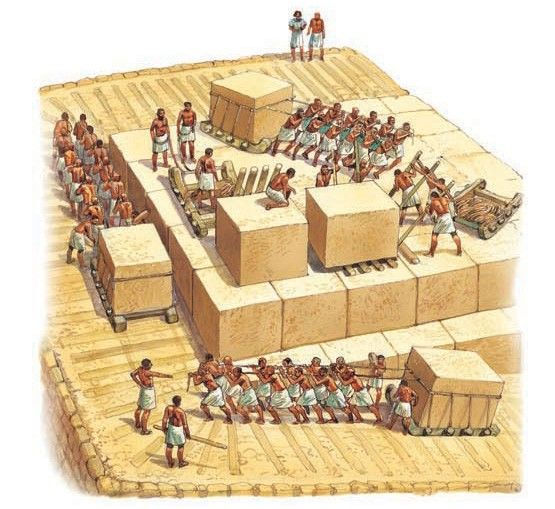Engineering Mysteries Behind The Great Pyramids Of Giza
- Güney Baver Gürbüz
- 28 Ara 2021
- 3 dakikada okunur
Believed to have been built roughly somewhere between 2550 and 2400 B.C, The Great Giza Pyramids have been one of the most mysterious architectural wonders in the world. Despite being so infamous, these pyramids fascinate all scientists and engineers around the world as simple questions like exactly how they were built continue to remain as a source of debate amongst these people. However, the mystery behind the engineering of these pyramids can actually be divulged to some extent.

Considering their history, the sizes of these pyramids become inconceivable. The largest and first pyramid at Giza ( Great Pyramid) stands at 138 meters tall. The next pyramid is slightly smaller than the Great Pyramid but elevation-wise is taller thanks to a higher base. The final pyramid is the smallest, standing at only 65 m high. These structures, mainly the Great Pyramid, stood as the tallest structures ever built for 3800 years – much of recorded human history. It is estimated that the Great Pyramid, the biggest of the bunch, is made up of about 2.3 million stone blocks all on one foundation. This foundation is an engineering phenomenon all by itself. The Egyptians designed and used simple tools to construct this foundation. They used plumb bobs and square levels- which were made of wood, twine, and lightweight stones- to ensure that the corners of blocks were square and that surfaces were flat. In fact, the pyramid's base was probably the biggest flatted surface built on earth at that time. Also, to smooth the sides of the stones, copper chisels were used. Large dolerite stones were used as pounders to excavate the channels needed to free a blockage from the bedrock. Lastly, a mushroom-shaped stone with three grooves cut across the round section probably acted as a primitive pulley that could redirect the force on the ropes used to move blocks. All these tools needed to perform the operations have been discovered from archaeological excavations. The pyramids are made from Limestone which was quarried right next to the building site. The workers determined the thickness of each block by the thickness of the limestone layers in the quarry. These lines would naturally separate with less force. Workers would dig channels down the side of the stone, then use large pry bars to create cracks that would eventually break. Even though the process of the construction of the pyramids is assumed in this way,
how the stones were transported is another question.

Researchers recently came to the conclusion that Egyptians likely used sleds that were pulled over damp sand to reduce friction. This technique would've allowed the pulling force to be reduced by 50 percent, thus cutting down on the effort needed to move the stones. To prevent possible confusion, only the external stone covering the pyramids traveled a long distance; the other Limestones were found directly near the pyramids. It is believed that thousands of people worked to construct these magnificent architects in such a short time as Egyptologists have found huge complicated cities surrounding the pyramid sites that housed entire families, thousands of skilled workers. Even though it’s known how these pyramids were constructed, there is still a great deal of enigma behind these pyramids.
There have been many different proposals for technology that could potentially help unearth the remaining mysteries of the Great Pyramids. In 2017, scientists announced that they have utilized particle physics to look inside of the pyramids, and they discovered a huge cavity that's over 30 meters long. The purpose of this void — known as ScanPyramids Big Void, is unknown, but its dimensions are very similar to the Grand Gallery, which leads to what was once the final resting place of Pharoh Khufu.

The scientist calls this amazing technology used for this amazing discovery, muon radiography. Muon radiography is a technique that uses cosmic ray muons to generate three-dimensional images of volumes using information contained in the Coulomb scattering of the muons. Scientists use these muons, unstable subatomic particles similar to electrons, but with a much greater mass, to pierce through the pyramid's tough exterior and help map what lies inside. Muons are generated when cosmic rays — high-energy particles from the Sun — collide with atoms in Earth's atmosphere. In spite of the fact that scientists couldn’t unearth the whole mystery behind these pyramids via muon radiography, scientists and archaeologists are always seeking ways in which we can use technology to shed light on the secrets of the pyramids. Hopefully, one day, humanity will be able to discover exactly how these astounding structures were built.
References:
“The Engineering Behind the Pyramids.” YouTube, YouTube, 18 June 2018, www.youtube.com/watch?v=YzNX-fJnOKE&t=6s.
“." World Eras. . Encyclopedia.com. 15 Apr. 2021 .” Encyclopedia.com, Encyclopedia.com, 17 Apr. 2021, www.encyclopedia.com/history/news-wires-white-papers-and-books/technology-and-engineering-building-pyramids.
“Muon Imaging Goes 3D : from Muography to Muon Tomography.” Département D'Electronique, Des Détecteurs Et D'Informatique Pour La Physique, irfu.cea.fr/dedip/en/Phocea/Vie_des_labos/Ast/ast.php?t=fait_marquant&id_ast=4622.



Yorumlar